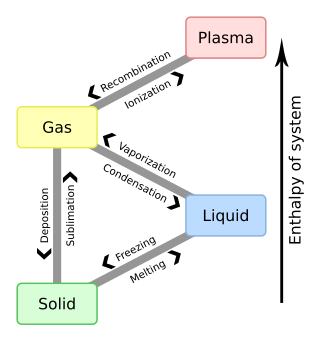State of matter
Matter in the liquid state maintains a fixed volume (assuming no change in temperature or air pressure), but has a variable shape that adapts to fit its container.Matter in the plasma state has variable volume and shape, and contains neutral atoms as well as a significant number of ions and electrons, both of which can move around freely.In crystalline solids, the particles (atoms, molecules, or ions) are packed in a regularly ordered, repeating pattern.A liquid is a nearly incompressible fluid that conforms to the shape of its container but retains a (nearly) constant volume independent of pressure.Intermolecular (or interatomic or interionic) forces are still important, but the molecules have enough energy to move relative to each other and the structure is mobile.[3] A gas is usually converted to a plasma in one of two ways, either from a huge voltage difference between two points, or by exposing it to extremely high temperatures.The Sun's corona, some types of flame, and stars are all examples of illuminated matter in the plasma state.The anion and cation are not necessarily compatible and would demix otherwise, but electric charge attraction prevents them from separating.Their anions and cations appear to diffuse within compartmentalized layers or micelles instead of freely as in a uniform liquid.[11] Transition metal atoms often have magnetic moments due to the net spin of electrons that remain unpaired and do not form chemical bonds.In some solids the magnetic moments on different atoms are ordered and can form a ferromagnet, an antiferromagnet or a ferrimagnet.The phenomenon of superconductivity was discovered in 1911, and for 75 years was only known in some metals and metallic alloys at temperatures below 30 K. In 1986 so-called high-temperature superconductivity was discovered in certain ceramic oxides, and has now been observed in temperatures as high as 164 K.[13] Close to absolute zero, some liquids form a second liquid state described as superfluid because it has zero viscosity (or infinite fluidity; i.e., flowing without friction).These properties are explained by the theory that the common isotope helium-4 forms a Bose–Einstein condensate (see next section) in the superfluid state.[15] In 1924, Albert Einstein and Satyendra Nath Bose predicted the "Bose–Einstein condensate" (BEC), sometimes referred to as the fifth state of matter.In 1995, the research groups of Eric Cornell and Carl Wieman, of JILA at the University of Colorado at Boulder, produced the first such condensate experimentally.Degenerate matter is supported by the Pauli exclusion principle, which prevents two fermionic particles from occupying the same quantum state.Vast gravitational pressure compresses atoms so strongly that the electrons are forced to combine with protons via inverse beta-decay, resulting in a superdense conglomeration of neutrons.Cold degenerate matter is also present in planets such as Jupiter and in the even more massive brown dwarfs, which are expected to have a core with metallic hydrogen.In metals, the electrons can be modeled as a degenerate gas moving in a lattice of non-degenerate positive ions.This state is briefly attainable in extremely high-energy heavy ion collisions in particle accelerators, and allows scientists to observe the properties of individual quarks.Theories predicting the existence of quark–gluon plasma were developed in the late 1970s and early 1980s,[16] and it was detected for the first time in the laboratory at CERN in the year 2000.Color-glass condensate is a type of matter theorized to exist in atomic nuclei traveling near the speed of light.According to Einstein's theory of relativity, a high-energy nucleus appears length contracted, or compressed, along its direction of motion.As a result, the gluons inside the nucleus appear to a stationary observer as a "gluonic wall" traveling near the speed of light.This is a result of being subjected to high temperature and pressure, leading to the chains in the potassium to dissolve into liquid while the crystals remain solid.A quantum spin Hall state is a theoretical phase that may pave the way for the development of electronic devices that dissipate less energy and generate less heat.







Phase (matter)List of states of matterBromineliquidacrylicHeliumplasmaphysicsmatterliquid crystalBose–Einstein condensatesFermionic condensatesneutron-degenerate matterquark–gluon plasmahigh energyvolumemoleculeselectronssynonymphases of icecrystal structuresforces between particlescrystalline solidsbody-centred cubicface-centred cubicGlassesamorphous solidslong-range orderthermal equilibriumsublimationdepositiontemperaturepressuremelting pointtriple pointcritical temperaturekinetic energyideal gasboiling pointvapor pressuresupercritical fluidcritical pressuresupercritical carbon dioxideextractcaffeinedecaffeinatedPlasma (physics)potential differenceionizelightningelectric sparksfluorescent lightsneon lightsplasma televisionsSun's coronaordinary matterPhase transitionsstatesphase transitionsuperconductiveferromagneticmesophasesMeltingFreezingVaporizationCondensationIonizationRecombinationabsolute zeroSuperfluidsFermionic condensateaqueous solutionamorphous solidglass transitionsilicateionic meltsaqueous solutionspolymersmetastable stateplastic crystalorientational glassquenched disorderedspin glassnematic phasepara-azoxyanisoleliquid crystal displaysCopolymerCopolymersstyrene-butadiene-styrene block copolymercovalently bondednanometre-sizedIonic liquidsTransition metalmagnetic momentsferromagnetmagnetic domainmagnetmagnetic fieldmagnetizationCurie pointantiferromagnetnickel(II) oxideferrimagnetmagnetitequantum spin liquidgeometrically frustratedSuperconductivityelectrical resistivityMeissner effectdiamagnetismSuperconducting magnetsmagnetic resonance imaginghigh-temperature superconductivityceramicLiquid heliumRollin filmSuperfluidviscositylambda temperaturethermal conductivitytemperature gradientquantized vorticeshelium-4Bose–Einstein condensatehelium-3lithium-6